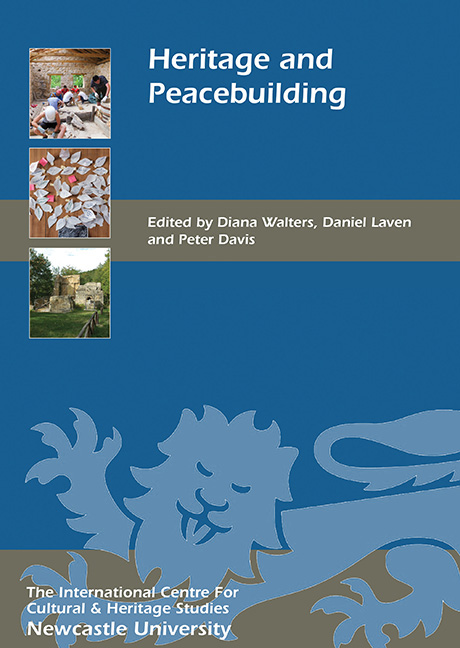Book contents
- Frontmatter
- Contents
- List of illustrations
- Acknowledgements
- List of abbreviations
- Preface
- Introduction
- NEW AND EMERGING IDEAS AROUND HERITAGE AND PEACE
- 1 The Heritage of Peace: the Importance of Peace Museums for the Development of a Culture of Peace
- 2 A Conversation with Seth Frankel: Designing Exhibitions for Peace
- 3 Public Spaces for Strangers: the Foundation for Peacebuilding and Implications for Heritage Institutions
- 4 Can Museums Build Peace? The Role of Museums in Peacebuilding and Internationalism
- 5 Information and Communication Technologies for Heritage and Peacebuilding
- 6 A Conversation with David Fleming: the Role of National Museums Liverpool in Social Justice and Peacebuilding
- HERITAGE AND PEACEBUILDING IN PRACTICE
- HERITAGE, PEACEBUILDING AND SITES
- List of Contributors
- Index
- Previous Titles
2 - A Conversation with Seth Frankel: Designing Exhibitions for Peace
from NEW AND EMERGING IDEAS AROUND HERITAGE AND PEACE
Published online by Cambridge University Press: 16 February 2018
- Frontmatter
- Contents
- List of illustrations
- Acknowledgements
- List of abbreviations
- Preface
- Introduction
- NEW AND EMERGING IDEAS AROUND HERITAGE AND PEACE
- 1 The Heritage of Peace: the Importance of Peace Museums for the Development of a Culture of Peace
- 2 A Conversation with Seth Frankel: Designing Exhibitions for Peace
- 3 Public Spaces for Strangers: the Foundation for Peacebuilding and Implications for Heritage Institutions
- 4 Can Museums Build Peace? The Role of Museums in Peacebuilding and Internationalism
- 5 Information and Communication Technologies for Heritage and Peacebuilding
- 6 A Conversation with David Fleming: the Role of National Museums Liverpool in Social Justice and Peacebuilding
- HERITAGE AND PEACEBUILDING IN PRACTICE
- HERITAGE, PEACEBUILDING AND SITES
- List of Contributors
- Index
- Previous Titles
Summary
Can you say something about yourself and your interest in peacebuilding? What brought you into the field?
My formal education is in both industrial design and sustainable development. In design, there's an opportunity to connect to audiences/viewers/customers in vast numbers. But rather than designing ‘things,’ I have chosen to design exhibitions. As a younger designer beginning at the Smithsonian Institution, I felt the power of its institutional mission. I was strongly drawn to this field. They provide a platform for presenting stories that improve the human condition.
Museums are entrusted with the responsibility of telling our most important stories, and they take that obligation very seriously. Their place in society as informal learning environments gives them a unique position outside of both academia and pop culture. My own exhibition design and planning career has been incredibly diverse – from art to zoos, from deeply complex stories of conflict to foamy exhibits on beer. In all of my work I have felt drawn to crafting expressions of the human condition – from joy to despair, from suffering to enduring hope – that visitors can respond to on many levels.
How have peace museums changed over time and how do you see them evolving into the future?
The peace museum movement largely took root during the highly charged period of activism of the 1960s. In particular, early peace museums in Japan (many set within universities) were developed as responses to both the atomic bombs dropped during World War II and the nation's reliance on nuclear power to meet growing energy needs. Early museums served as places to document events, centres for activist engagement and conduits for disseminating information.
In other parts of the world peace museums took on a similarly responsive mission, documenting and sharing significant history and sites. In the US The Peace Museum (1981) in Chicago began by connecting peaceful endeavours to the visual arts; the Dayton International Peace Museum (2004) provides traditional museum exhibits and serves as an activity centre for children and adults seeking to understand non-violent solutions to social problems. Elsewhere, in Europe and Asia, peace museums take on similar missions: interpreting events and delivering broader education in non-violence.
- Type
- Chapter
- Information
- Heritage and Peacebuilding , pp. 17 - 24Publisher: Boydell & BrewerPrint publication year: 2017



